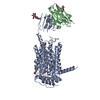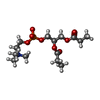+ Open data
Open data
- Basic information
Basic information
| Entry | Database: PDB / ID: 8uo8 | ||||||
|---|---|---|---|---|---|---|---|
| Title | Structure of synaptic vesicle protein 2B with padsevonil | ||||||
 Components Components | Synaptic vesicle glycoprotein 2B | ||||||
 Keywords Keywords | TRANSPORT PROTEIN / Synaptic vesicle / SLC22 / Inhibitor / Antiepileptic | ||||||
| Function / homology |  Function and homology information Function and homology informationToxicity of botulinum toxin type F (botF) / Toxicity of botulinum toxin type D (botD) / Toxicity of botulinum toxin type E (botE) / Toxicity of botulinum toxin type A (botA) / regulation of presynaptic cytosolic calcium ion concentration / neurotransmitter transport / regulation of synaptic vesicle exocytosis / transmembrane transporter activity / acrosomal vesicle / synaptic vesicle ...Toxicity of botulinum toxin type F (botF) / Toxicity of botulinum toxin type D (botD) / Toxicity of botulinum toxin type E (botE) / Toxicity of botulinum toxin type A (botA) / regulation of presynaptic cytosolic calcium ion concentration / neurotransmitter transport / regulation of synaptic vesicle exocytosis / transmembrane transporter activity / acrosomal vesicle / synaptic vesicle / synaptic vesicle membrane / chemical synaptic transmission / membrane / plasma membrane Similarity search - Function | ||||||
| Biological species |  Homo sapiens (human) Homo sapiens (human) | ||||||
| Method | ELECTRON MICROSCOPY / single particle reconstruction / cryo EM / Resolution: 3.2 Å | ||||||
 Authors Authors | Martin, M.F. / Mittal, A. / Levin, E. / Adams, C. / Yang, M. / Ledecq, M. / Horanyi, P.S. / Coleman, J.A. | ||||||
| Funding support |  United States, 1items United States, 1items
| ||||||
 Citation Citation |  Journal: Nat Struct Mol Biol / Year: 2024 Journal: Nat Struct Mol Biol / Year: 2024Title: Structures of synaptic vesicle protein 2A and 2B bound to anticonvulsants. Authors: Anshumali Mittal / Matthew F Martin / Elena J Levin / Christopher Adams / Meng Yang / Laurent Provins / Adrian Hall / Martin Procter / Marie Ledecq / Alexander Hillisch / Christian Wolff / ...Authors: Anshumali Mittal / Matthew F Martin / Elena J Levin / Christopher Adams / Meng Yang / Laurent Provins / Adrian Hall / Martin Procter / Marie Ledecq / Alexander Hillisch / Christian Wolff / Michel Gillard / Peter S Horanyi / Jonathan A Coleman /     Abstract: Epilepsy is a common neurological disorder characterized by abnormal activity of neuronal networks, leading to seizures. The racetam class of anti-seizure medications bind specifically to a membrane ...Epilepsy is a common neurological disorder characterized by abnormal activity of neuronal networks, leading to seizures. The racetam class of anti-seizure medications bind specifically to a membrane protein found in the synaptic vesicles of neurons called synaptic vesicle protein 2 (SV2) A (SV2A). SV2A belongs to an orphan subfamily of the solute carrier 22 organic ion transporter family that also includes SV2B and SV2C. The molecular basis for how anti-seizure medications act on SV2s remains unknown. Here we report cryo-electron microscopy structures of SV2A and SV2B captured in a luminal-occluded conformation complexed with anticonvulsant ligands. The conformation bound by anticonvulsants resembles an inhibited transporter with closed luminal and intracellular gates. Anticonvulsants bind to a highly conserved central site in SV2s. These structures provide blueprints for future drug design and will facilitate future investigations into the biological function of SV2s. | ||||||
| History |
|
- Structure visualization
Structure visualization
| Structure viewer | Molecule:  Molmil Molmil Jmol/JSmol Jmol/JSmol |
|---|
- Downloads & links
Downloads & links
- Download
Download
| PDBx/mmCIF format |  8uo8.cif.gz 8uo8.cif.gz | 124.2 KB | Display |  PDBx/mmCIF format PDBx/mmCIF format |
|---|---|---|---|---|
| PDB format |  pdb8uo8.ent.gz pdb8uo8.ent.gz | Display |  PDB format PDB format | |
| PDBx/mmJSON format |  8uo8.json.gz 8uo8.json.gz | Tree view |  PDBx/mmJSON format PDBx/mmJSON format | |
| Others |  Other downloads Other downloads |
-Validation report
| Summary document |  8uo8_validation.pdf.gz 8uo8_validation.pdf.gz | 1.9 MB | Display |  wwPDB validaton report wwPDB validaton report |
|---|---|---|---|---|
| Full document |  8uo8_full_validation.pdf.gz 8uo8_full_validation.pdf.gz | 1.9 MB | Display | |
| Data in XML |  8uo8_validation.xml.gz 8uo8_validation.xml.gz | 38 KB | Display | |
| Data in CIF |  8uo8_validation.cif.gz 8uo8_validation.cif.gz | 53.5 KB | Display | |
| Arichive directory |  https://data.pdbj.org/pub/pdb/validation_reports/uo/8uo8 https://data.pdbj.org/pub/pdb/validation_reports/uo/8uo8 ftp://data.pdbj.org/pub/pdb/validation_reports/uo/8uo8 ftp://data.pdbj.org/pub/pdb/validation_reports/uo/8uo8 | HTTPS FTP |
-Related structure data
| Related structure data |  42430MC  8uo9C  8uoaC M: map data used to model this data C: citing same article ( |
|---|---|
| Similar structure data | Similarity search - Function & homology  F&H Search F&H Search |
- Links
Links
- Assembly
Assembly
| Deposited unit | 
|
|---|---|
| 1 |
|
- Components
Components
-Protein / Sugars , 2 types, 4 molecules A

| #1: Protein | Mass: 77515.016 Da / Num. of mol.: 1 Source method: isolated from a genetically manipulated source Source: (gene. exp.)  Homo sapiens (human) / Gene: SV2B / Cell line (production host): tSA201 / Production host: Homo sapiens (human) / Gene: SV2B / Cell line (production host): tSA201 / Production host:  Homo sapiens (human) / References: UniProt: Q7L1I2 Homo sapiens (human) / References: UniProt: Q7L1I2 |
|---|---|
| #2: Sugar |
-Non-polymers , 6 types, 11 molecules 








| #3: Chemical | ChemComp-X3U / ( Mass: 432.797 Da / Num. of mol.: 1 / Source method: obtained synthetically / Formula: C14H14ClF5N4O2S / Feature type: SUBJECT OF INVESTIGATION | ||||||
|---|---|---|---|---|---|---|---|
| #4: Chemical | ChemComp-PS1 / | ||||||
| #5: Chemical | | #6: Chemical | ChemComp-43Y / [( | #7: Chemical | ChemComp-Y01 / | #8: Water | ChemComp-HOH / | |
-Details
| Has ligand of interest | Y |
|---|---|
| Has protein modification | Y |
-Experimental details
-Experiment
| Experiment | Method: ELECTRON MICROSCOPY |
|---|---|
| EM experiment | Aggregation state: PARTICLE / 3D reconstruction method: single particle reconstruction |
- Sample preparation
Sample preparation
| Component | Name: SV2B complexed with padsevonil / Type: COMPLEX / Entity ID: #1 / Source: RECOMBINANT |
|---|---|
| Molecular weight | Value: 77.4 kDa/nm / Experimental value: NO |
| Source (natural) | Organism:  Homo sapiens (human) Homo sapiens (human) |
| Source (recombinant) | Organism:  Homo sapiens (human) Homo sapiens (human) |
| Buffer solution | pH: 8 Details: 150 mM NaCl, 20 mM Tris pH 8.0, .4 mM glyco-diosgenin, 1 uM padsevonil |
| Specimen | Conc.: 4 mg/ml / Embedding applied: NO / Shadowing applied: NO / Staining applied: NO / Vitrification applied: YES |
| Specimen support | Grid material: GOLD / Grid mesh size: 200 divisions/in. / Grid type: Quantifoil R2/1 |
| Vitrification | Instrument: FEI VITROBOT MARK IV / Cryogen name: ETHANE-PROPANE / Humidity: 100 % / Chamber temperature: 298 K |
- Electron microscopy imaging
Electron microscopy imaging
| Experimental equipment |  Model: Titan Krios / Image courtesy: FEI Company |
|---|---|
| Microscopy | Model: TFS KRIOS |
| Electron gun | Electron source:  FIELD EMISSION GUN / Accelerating voltage: 300 kV / Illumination mode: FLOOD BEAM FIELD EMISSION GUN / Accelerating voltage: 300 kV / Illumination mode: FLOOD BEAM |
| Electron lens | Mode: BRIGHT FIELD / Nominal magnification: 194000 X / Nominal defocus max: 1500 nm / Nominal defocus min: 500 nm |
| Image recording | Electron dose: 60 e/Å2 / Film or detector model: TFS FALCON 4i (4k x 4k) |
| EM imaging optics | Energyfilter name: TFS Selectris / Energyfilter slit width: 10 eV |
- Processing
Processing
| EM software |
| ||||||||||||||||||||||||
|---|---|---|---|---|---|---|---|---|---|---|---|---|---|---|---|---|---|---|---|---|---|---|---|---|---|
| CTF correction | Type: PHASE FLIPPING AND AMPLITUDE CORRECTION | ||||||||||||||||||||||||
| 3D reconstruction | Resolution: 3.2 Å / Resolution method: FSC 0.143 CUT-OFF / Num. of particles: 62528 / Symmetry type: POINT | ||||||||||||||||||||||||
| Atomic model building | Accession code: AF-Q7L1I2-F1 / Source name: AlphaFold / Type: in silico model | ||||||||||||||||||||||||
| Refine LS restraints |
|
 Movie
Movie Controller
Controller





 PDBj
PDBj








